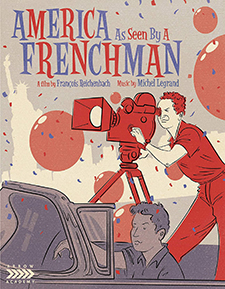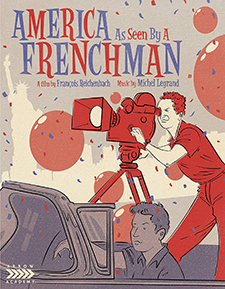America as Seen by a Frenchman (Blu-ray Review)

Director
Francois ReichenbachRelease Date(s)
1960 (June 2, 2020)Studio(s)
Les Films de la Pleiade (Arrow Academy)- Film/Program Grade: D
- Video Grade: B
- Audio Grade: B-
- Extras Grade: C+
Review
For 20 years, from 1934 and 1954, MGM released a series of Technicolor Traveltalks, short subjects featuring colorful images of cities and countries, narrated by James A. FitzPatrick, to accompany the studio’s feature films. With the rise of television in the 1950s, the series faded. In 1960, a French film turned its sights on life and activities in the United States.
Toward the end of the 50s, French director Francois Reichenbach spent a year and a half traveling across the United States, filming whatever piqued his interest. The result, America as Seen by a Frenchman, is a random collection of images that jump from location to location without a narrative thread. A visual time capsule of sorts, the film is a set of glimpses of the country on the cusp between two decades. Because it was shot before the turbulence of civil unrest, assassinations, an unpopular war, and the coming of age of the baby boomer generation, the film has the nostalgic feel of a bygone era.
Among the brief episodes are shots of the Golden Gate Bridge, an annual recreation of covered wagons heading west, a Santa Monica fashion shoot, an energetic dancer (Look closely... is that Mary Tyler Moore?), massive farming equipment at work, attractions at Disneyland, a prison rodeo, a festival of twins, several parades, a Red Cross class for fathers-to-be, kids playing street games, a diving horse, Soap Box Derby, teenagers blowing gum bubbles and flirting, and a newsboy on his bike delivering newspapers. There’s even a little boy eating the Kitchen Sink, which is an enormous ice cream sundae. If you remember Jahn’s restaurants, you’ll recognize it.
The film is rather mundane until a section turns up about juvenile delinquents in a line-up and being fingerprinted by the police. There also are images that reveal the deep-rooted segregation of the period. The narration doesn’t comment on it. We just see it.
An overly orchestrated score by Michel Legrand often sounds silly, as when it accompanies a shot of a harvester coming over a wheat field horizon or attempts to make ordinary, non-dramatic images seem more important than they are. The score would have been more at home in a low-budget Biblical epic.
The primary problem with the film is its complete absence of a point of view or, for that matter, a point. Reichenbach made short documentaries for most of his career, but they had themes and were focused. America as Seen by a Frenchman is like looking at hundreds of unedited pictures taken on a cross-country vacation. They’re interesting to a degree, but without meaningful cohesion, they make for a long slog without much of a payoff. The director is eclectic in his choice of subjects. Anything that caught his fancy is included. The film may have played well in France, where viewers could get a sociological glimpse of American life. But for an American viewer, seeing the activities, clothing, and hairstyles of 60 years ago may be the film’s main attraction.
Featuring 1080p resolution, the film is presented on Blu-ray by Arrow Academy in the widescreen aspect ratio of 2.35:1. Overall, color values are rich, with blues and reds really popping. The parade sequences are especially vibrant, with the costumed marching bands, baton-twirling majorettes, and floats. Reichenbach makes use of the wide angle lens in a panoramic shot of the Golden Gate Bridge, a covered wagon convoy, jet fighters taking off from an aircraft carrier, and a prison rodeo. Color is nicely saturated. Detail is sharp, with facial close-ups showing individual strands of hair, stubble, birth marks and, on older people, wrinkles. Some interiors are less sharp due to low lighting.
The soundtrack is uncompressed 1.0 LPCM mono in the original French. English subtitles are optional. The Michel Legrand score dominates, with very lush, often inappropriate arrangements that sound too grand for the images. The narration often seems written to justify the images rather than explain or elucidate them. Often heavy-handed, the narration comes close to sounding like psychobabble.
Bonus materials include a video appreciation of the film, an image gallery, a booklet containing a critical essay, and a reversible sleeve featuring original and newly commissioned artwork.
F for French – Film historian, author, and critic Philip Kemp discusses director Francois Reichenbach, a nearly forgotten member of the French New Wave of filmmakers that included Truffaut, Godard, Rohmer, and Chabrol. This movement of the late 50s and early 60s revolutionized world cinema. Reichenbach rarely made feature films. America as Seen by a Frenchman was his third. Most of his work was in short-form documentaries. He was born in 1921 to affluent parents and, at an early age, made a habit of secretly observing people. He studied music in Geneva, wrote songs, loved art, and became a technical advisor to American museums, suggesting which paintings to buy from Europe. He dabbled in filmmaking in the early 50s. He was so impressed with New York that he became fascinated by American society. He made documentaries for 25 years, each focusing on some aspect of American life. One of his best was Les Marines, about the basic training of new Marine recruits who face brutality and inhumanity as drill sergeants degrade and humiliate them. His goal in America as Seen by a Frenchman was to depict America paradoxically: “Everything you heard about it is true. Everything you heard about it is false.” When asked how he gained access to the events and places shown in the film, Reichennbach claimed that all he had to do was show nude photographs of Brigitte Bardot. The director’s approach to filming is referred to as “spontaneous expressionism.”
Image Gallery – A few color photos from the film are shown. These are duplicated in the enclosed booklet.
Booklet – The 24-page insert booklet contains a critical essay by Caspar Salmon, a list of production credits, 8 color photos, and a color reproduction of the original poster.
– Dennis Seuling

